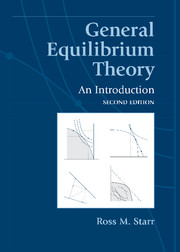Book contents
- Frontmatter
- Contents
- List of illustrations
- Introduction to the second edition
- Preface to the second edition
- Preface to the first edition
- Table of notation
- Table of assumptions
- A General equilibrium theory: Getting acquainted
- B Mathematics
- 6 Logic and set theory
- 7 RN: Real N-dimensional Euclidean space
- 8 Convex sets, separation theorems, and nonconvex sets in RN
- 9 The Brouwer Fixed-Point Theorem
- C An economy with bounded production technology and supply and demand functions
- D An economy with unbounded production technology and supply and demand functions
- E Welfare economics and the scope of markets
- F Bargaining and equilibrium: The core
- G An economy with supply and demand correspondences
- H Standing on the shoulders of giants
- Bibliography
- Index
7 - RN: Real N-dimensional Euclidean space
from B - Mathematics
Published online by Cambridge University Press: 05 June 2012
- Frontmatter
- Contents
- List of illustrations
- Introduction to the second edition
- Preface to the second edition
- Preface to the first edition
- Table of notation
- Table of assumptions
- A General equilibrium theory: Getting acquainted
- B Mathematics
- 6 Logic and set theory
- 7 RN: Real N-dimensional Euclidean space
- 8 Convex sets, separation theorems, and nonconvex sets in RN
- 9 The Brouwer Fixed-Point Theorem
- C An economy with bounded production technology and supply and demand functions
- D An economy with unbounded production technology and supply and demand functions
- E Welfare economics and the scope of markets
- F Bargaining and equilibrium: The core
- G An economy with supply and demand correspondences
- H Standing on the shoulders of giants
- Bibliography
- Index
Summary
Most of the sets, functions, and relations we will deal with are represented in real N-dimensional Euclidean space. The space is the N-fold Cartesian product of the real line, R, with itself, using the Euclidean metric (a measure of distance between points of the set). N is taken to be a (finite) positive integer. We typically take N as the number of commodities in the economy. We are familiar with R2 as the plane of the blackboard or the page and R3 as the conventional view of threedimensional space. Visualizing RN for large N may take rather more imagination but the mathematical principles of working in this space are the same as in R2 or R3.
Definition of ROur understanding of RN starts with our understanding of R. R is the space of real numbers, positive and negative: the rationals, irrationals, and integers. It is the real line consisting of all finite (positive and negative) real numbers.
There is no limit to how large an element of R can be; there is no limit how negative (that is, large in absolute value but of negative sign) an element of R can be. We describe this property by saying there are elements of R “arbitrarily large” or “arbitrarily negative.” Nevertheless, ±∞ are not elements of R; rather, that notation describes the process of moving through elements that are arbitrarily large or negative. Addition, subtraction, multiplication, and division are useful operations on R and, of course, retain their familiar properties.
- Type
- Chapter
- Information
- General Equilibrium TheoryAn Introduction, pp. 75 - 90Publisher: Cambridge University PressPrint publication year: 2011



